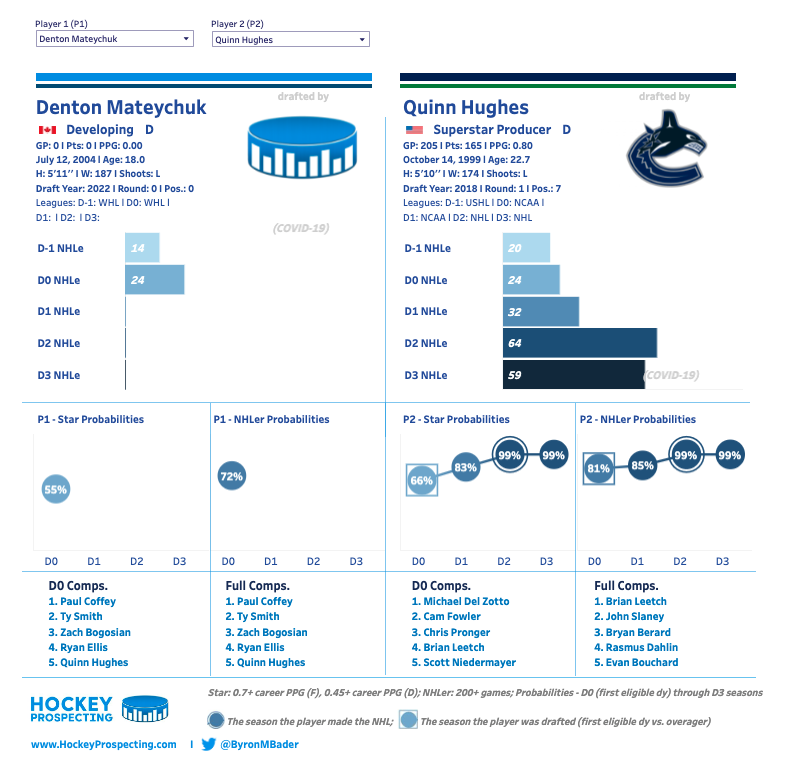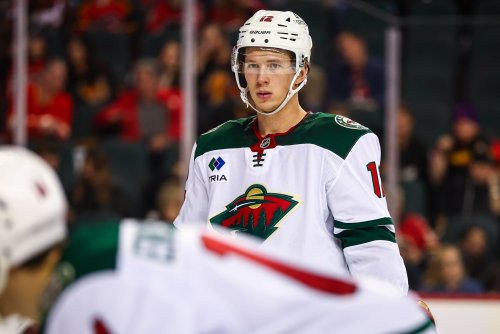
Ten years ago, the Minnesota Wild drafted Matt Dumba with the seventh overall pick in the 2012 Draft. Dumba became an offensive complement to Jonas Brodin, whom they selected at 11th overall the year prior. The idea behind the picks was simple: Draft a defensive pairing that could become a cornerstone of the franchise.
For the most part, this worked well. A decade later, both are patrolling the Wild blue line for well over 20 minutes a game. It took a bit to develop chemistry, but they were the offensive/defensive 1-2 punch Minnesota envisioned at their peak. Even now, after a pectoral injury wrecked Dumba's offensive upside, they're still an effective shutdown pair.
But since 2012, Minnesota's made little effort to build up the next generation of defensemen. Of their next 18 picks in the first three rounds of the draft, the Wild chased offense almost exclusively. The only defensemen picked among them were Gustav Olofsson (2nd round, 2013), Louis Belpedio (3rd round, 2014), and Filip Johansson (1st round, 2018). The trio had a combined 60 games in a Wild sweater.
So in the last three drafts, adding young defensive depth became a priority again. General manager Bill Guerin and head scout Judd Brackett took Ryan O'Rourke and Daemon Hunt in 2020, then followed it up in 2021 with Carson Lambos and Jack Peart.
Even after taking four defensemen with high picks in two years -- again, more than they had in almost a decade -- Guerin and Brackett may not be done beefing up the blueline. In Corey Pronman's recent mock draft for The Athletic, he slotted defenseman Denton Mateychuk to the Wild at pick 24.
Minnesota doesn't need to bother sending a scout to the WHL's Moose Jaw Warriors to get the scoop on Mateychuk, either. They can just give his defensive partner Hunt a call.
That's right. If Minnesota drafts Mateychuk, not only will they get an offensive complement to the tough, defensively-minded Hunt. They'll get a potential partner for Hunt that already comes with a year of built-in chemistry.
"We definitely play off each other in the D zone and in the offensive zone," Mateychuk told Moose Jaw's official website in a profile. "When you play with a guy like that, you develop a bit of habits and see what he does and what you can do to complement him and the other way around."
Whatever they're doing, it's working. Hunt had a solid offensive season, scoring 39 points in 46 games, even while dealing with injuries that prevented him from playing for Team Canada at the World Juniors. When the Wild drafted Hunt, most scouts thought his upside was that of a solid, physical defensive defenseman. It's clear now that Hunt has a chance to be a little more than that.
His offensive production rose from just 0.54 points per game in his draft year to 0.78 in the COVID-shortened season to 0.85 this season. As Hunt became older and stronger than his opposition, we can expect a jump in points. Still, you want to see growth over stagnation, and Hunt certainly accomplished the former.
Hunt's 17 goals were fourth in the WHL, as well. The league leader, Chad Nychuk with 21 tallies, played 18 more games than Hunt.
As interesting of a prospect as Hunt is, though, Mateychuk is posting jaw-dropping numbers as a 17-year-old. He scored 64 points in 65 games, just barely missing the point-per-game mark. WHL defensemen with comparable production in their draft years this century include long-time defenseman Jay Bouwmeester, Ivan Provorov, and budding star Bowen Byram. He's well ahead of where first-rounders Dumba, Seth Jones, and Shea Theodore were at that age.
So if those numbers are so good, why would Mateychuk fall to 24th overall, or even within striking range? It's that thing we all love to knock prospects for: size. He's 5'11", which somehow, someway, still matters to NHL teams. It could even matter to Minnesota, who's wanted to bulk up on defense.
But that should be covered by other prospects in their system. Lambos is 6'1", as are Hunt and O'Rourke, who both have a reputation for being nasty players. Mateychuk might be smaller, but he's no slouch in the defensive zone. Scott Wheeler of The Athletic says of him, "He plays a reliable and calculating game built around his mobility and sound decision-making... and [can] steer opposing players into tough spots despite not being the biggest guy." Jared Spurgeon should be proof that Mateychuk's style of defense is projectable.
Then there's the fact that Moose Jaw relies on him to spark the offense. Mitch Brown of Elite Prospects says in their Draft Guide, "Mateychuck averages 150 puck touches per game, more than 50 above the average top-pairing defenseman." Mateychuk isn't a Ryan Suter-type who touches the puck a lot and remains methodical and grinds down the pace, either.
"He's always sprinting up the ice," Brown states. "It's exhausting to be on the opposite side."
The way that Hunt and Mateychuk play, especially as a unit, is precisely what Dean Evason wants from his defensemen. Throughout the season, we saw not only Spurgeon, Brodin, and Dumba active in the offense but the likes of Dmitry Kulikov and Jon Merrill getting slapshots and breakaways.
Look at Hunt's goal here:
That's Mateychuk working the half-wall on the power play, with Hunt set poised to fire off a cannon from the point. Mateychuk is perfectly poised to be an extremely active offensive defenseman in Evason's system, with Hunt providing Brodin's safety-blanket role. Only Brodin doesn't have the kind of clap bomb Hunt has in his arsenal.
It's hard not to think of Mateychuk as a Brackett-type prospect. Byron Bader of Hockey Prospecting recently ranked Mateychuk fifth in his draft class. His model projects Mateychuk as having a 55% chance of being a star. Look at his top comparables, and you'll find Quinn Hughes, who Brackett picked 7th overall in 2018.
[caption id=attachment_127541" align="alignnone" width="809] Courtesy of Hockey Prospecting[/caption]
Courtesy of Hockey Prospecting[/caption]
It's understandable if the Wild want to find offense in this draft, particularly if and when they part with Kevin Fiala. But despite the "D" in front of his name on the depth chart, they'd get offensive production from Mateychuk. His chemistry with Hunt is another intriguing factor for the top prospect, and it's easy to see them continuing to grow in the organization together, much the same way Brodin and Dumba did a decade ago. The Wild should do backflips if Mateychuk falls to 24, and don't be shocked if they parlay Fiala into a high pick to grab him, either.
Think you could write a story like this? Hockey Wilderness wants you to develop your voice, find an audience, and we'll pay you to do it. Just fill out this form.









Recommended Comments
There are no comments to display.
Join the conversation
You can post now and register later. If you have an account, sign in now to post with your account.
Note: Your post will require moderator approval before it will be visible.